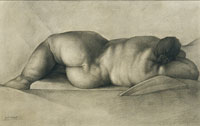
The paintings of Emil Bakalli aim at the deconstruction of human psychology, experience, and the esoteric language of mind and unconsciousness. In Bakalli’s works there is a reminiscent element of a melancholic and lost time and inner struggle; but also, his works capture the determination of hope and the conflict for existence. There are hints and features of nostalgia, drama, and survival from the hermetic former regime of communist Albania. Emil Bakalli was born in Albania, in the city of Elbasan, in 1975 where he finished the Lyceum of Fine Arts Onufri. He refers to the inhumane collapsed totalitarian regime of Stalinist Albania as a “bunker society”, which achieved one thing: the destruction of human essence, freedom, and character by deforming its soul and mind; creating a new poisonous and malicious hybrid society of Bolshevik paranoia for self-destruction. .
Bakalli’s work is often read with political motive. In his latest paintings one cannot m iss that, there is a certain attention to depicting figures and bodies in states of ambiguous duress. These figures are to great extent signifiers of the moral and political relationship of oppressor and oppressed leading to aberration and triumph. This particular subject matter of incongruousness reflects his reaction to political events evolving in an inner struggle. Bakalli is engaged in political thought studying the aspect of human existence—his thinking and vision is enriched from his interest and his readings of philosophy and theory, especially from 20th century German and French philosophy, psychology, and semiotics.
iss that, there is a certain attention to depicting figures and bodies in states of ambiguous duress. These figures are to great extent signifiers of the moral and political relationship of oppressor and oppressed leading to aberration and triumph. This particular subject matter of incongruousness reflects his reaction to political events evolving in an inner struggle. Bakalli is engaged in political thought studying the aspect of human existence—his thinking and vision is enriched from his interest and his readings of philosophy and theory, especially from 20th century German and French philosophy, psychology, and semiotics.
 Another element of his paintings is that he approaches painting through the prism of conceptualism. Allegory and metaphor, symbolism and metonymic connotations or coded elements are significant for understanding his work. For Bakalli, the process of painting is not only creativity, but also self-reflexivity. In addition to this, he believes that the element of process and concept in painting is as important as appearance. In his work one sees blocks of fracture, which direct our perception to discontinuity and ambiguity, combining schematic figural elements constructing a visual scene—that enables the viewer to be able to create his/her own story narrating in the absence of the real, visible or tangible event. Bakalli’s current paintings reflect his inner world radiating from the deepest memory of his esoteric and exoteric experience, handling chromatic schemes in accordance with the idea of his subject matter. For Bakalli, the whole process of art is after all an idea, which emanates from the dream-life-experience phenomenon of human mind. His current paintings have a ‘lateral semantic’ approach showing suggestiveness, indirection, and uncertainty—where the dream-world and life-experience are interconnect and create a new platform for connoted messages and meanings, demonstrating that events and phenomena evolve simultaneously and not in isolation. Bakalli’s paintings are embedded in an inner language, indicating that the reality of the exoteric appearances does not have to coincide with the esoteric language of mind; but together at once, they create a void—this is the place where the artist dominates, in the uncertainty of life and existence—the will as appearance and form, where the essence of the idea is represented in the process of art and in the labyrinth of life. .
Another element of his paintings is that he approaches painting through the prism of conceptualism. Allegory and metaphor, symbolism and metonymic connotations or coded elements are significant for understanding his work. For Bakalli, the process of painting is not only creativity, but also self-reflexivity. In addition to this, he believes that the element of process and concept in painting is as important as appearance. In his work one sees blocks of fracture, which direct our perception to discontinuity and ambiguity, combining schematic figural elements constructing a visual scene—that enables the viewer to be able to create his/her own story narrating in the absence of the real, visible or tangible event. Bakalli’s current paintings reflect his inner world radiating from the deepest memory of his esoteric and exoteric experience, handling chromatic schemes in accordance with the idea of his subject matter. For Bakalli, the whole process of art is after all an idea, which emanates from the dream-life-experience phenomenon of human mind. His current paintings have a ‘lateral semantic’ approach showing suggestiveness, indirection, and uncertainty—where the dream-world and life-experience are interconnect and create a new platform for connoted messages and meanings, demonstrating that events and phenomena evolve simultaneously and not in isolation. Bakalli’s paintings are embedded in an inner language, indicating that the reality of the exoteric appearances does not have to coincide with the esoteric language of mind; but together at once, they create a void—this is the place where the artist dominates, in the uncertainty of life and existence—the will as appearance and form, where the essence of the idea is represented in the process of art and in the labyrinth of life. .
No comments:
Post a Comment